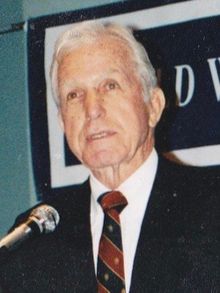Edgar Whitcomb
| Edgar Whitcomb | |
|---|---|
 |
|
| 43rd Governor of Indiana | |
|
In office January 13, 1969 – January 8, 1973 |
|
| Lieutenant | Richard Folz |
| Preceded by | Roger Branigin |
| Succeeded by | Otis Bowen |
| Secretary of State of Indiana | |
|
In office December 1, 1966 – December 1, 1968 |
|
| Governor | Roger Branigin |
| Preceded by | John Bortoff |
| Succeeded by | William Salin |
| Personal details | |
| Born |
Edgar Doud Whitcomb November 6, 1917 Hayden, Indiana, U.S. |
| Died | February 4, 2016 (aged 98) Rome, Indiana, U.S. |
| Political party | Republican |
| Spouse(s) |
Patricia Dolfus (m. 1953; div. 1986) Mary Evelyn Gayer (m. 2013; death 2016) |
| Children | 5 |
| Alma mater |
Indiana University, Bloomington Indiana University, Indianapolis |
| Military service | |
| Allegiance |
|
| Service/branch |
|
| Years of service | 1940–1946 (Army Air Corps) 1946–1977 (Army Reserve) |
| Rank |
|
| Battles/wars |
World War II • Philippines Campaign • Battle of Bataan • Battle of Corregidor |
Edgar Doud Whitcomb (November 6, 1917 – February 4, 2016) was an American politician, who was the 43rd Governor of Indiana. His term as governor began a major rift in the Indiana Republican Party as urban Republicans became more numerous than rural Republicans, leading to a shift in the priorities of the party leadership.
Whitcomb found himself opposed by speaker of the house Otis R. Bowen on a number of measures and for control of the party leadership. Despite his opposition, Whitcomb was able to increase tax revenue by 8% without raising tax rates through improved collection and auditing techniques, created a panel of business leaders to recommend governmental reforms aimed at increasing efficiency that allowed the state to reduce its workforce by 10% and fought for a number of budgetary saving measures primarily through reducing state employee wages and spending in non essential areas.
After leaving office, Whitcomb divorced from his wife of thirty-six years and took up sail boating. He sailed around the Mediterranean Sea, across the Atlantic Ocean in 1990, and geographically sailed around the world in 1995, although he was not able to return to his exact starting point, because his ship ran aground on a reef in the Gulf of Suez. After two days of trying to free the ship, he made the decision to abandon it. Returning to Indiana, he moved to a secluded log cabin on the banks of the Ohio River within the Hoosier National Forest near Rome, Indiana.
Whitcomb was born on November 6, 1917 in Hayden, Indiana, the second child and first son of John Whitcomb and Louise Doud Whitcomb. An outgoing and athletic youth, he was a member of his high school basketball team. He entered Indiana University in 1939 to study law, but quit school to join the military at the outbreak of World War II.
He enlisted in the United States Army Air Corps in 1940 and was deployed to the Pacific Theater. He was commissioned as a Lieutenant in 1941 and made an aerial navigator. He served two tours of duty in the Philippines and was promoted to Second Lieutenant. During the Philippines Campaign, Whitcomb's base was overrun; he was captured by the Japanese and was beaten and tortured by his captors, but was able to escape. Recaptured a few days later, he escaped a second time and was hunted for several more days but was able to evade his pursuers. He escaped by swimming all night through shark-infested waters to an island unoccupied by the Japanese army. He was eventually able to secure passage to China under an assumed name where he made contact with the United States Army and was repatriated in December 1943. He wrote a book about his experience entitled Escape from Corregidor, published in 1958. He was discharged from active duty in 1946, but he remained in the reserve military forces until 1977 holding the rank of colonel.
...
Wikipedia
